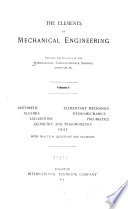 | International Correspondence Schools - Electrical engineering - 1897 - 672 pages
...Regard the remainder as a new dividend, and divide its first term by the first term of the divisor, for the second term of the quotient. Multiply the whole divisor by the second term of the quotient, and subtract the product from the first remainder. So proceed until a remainder of sera is found, or... | |
 | International Correspondence Schools - Civil engineering - 1899 - 722 pages
...Regard the remainder as a new dividend, and divide its first term by the first term of the divisor, for the second term of the quotient. Multiply the whole divisor by the second term of the quotient, and subtract the product from the first remainder. So proceed until a remainder of zero is found, or... | |
 | George Egbert Fisher, Isaac Joachim Schwatt - Algebra - 1900 - 200 pages
...product from the dividend. Divide the first term of the remainder by the first term of the divisor, and write the result as the second term of the quotient. Multiply the divisor by this second term of the quotient, and 3ubtract the product from the remainder previously... | |
 | James Morford Taylor - Algebra - 1900 - 504 pages
...product from the dividend. Divide the first term of the remainder by the first term of the divisor, and write the result as the second term of the quotient. Multiply the divisor by this second term of the quotient, and subtract the resulting product from the remainder... | |
 | George Egbert Fisher, Isaac Joachim Schwatt - Algebra - 1900 - 512 pages
...product from the dividend. Divide the first term of the remainder by the first term of the divisor, and write the result as the second term of the quotient. Multiply the divisor by this second term of the quotient, and subtract the product from the remainder previously... | |
 | George Egbert Fisher - 1901 - 622 pages
...product from the dividend. Divide the first term of the remainder by the first term of the divisor, and write the result as the second term of the quotient. Multiply the divisor by this second term of the quotient, and subtract the product from the remainder previously... | |
 | George Egbert Fisher, Isaac Joachim Schwatt - Algebra - 1901 - 646 pages
...product from the dividend. Divide the first term of the remainder by the first term of the divisor, and write the result as the second term of the quotient. Multiply the divisor by this second term of the quotient, and subtract tlie product from the remainder previously... | |
 | John Charles Stone, James Franklin Millis - Algebra - 1905 - 776 pages
...highest term of the remainder. Hence, dividing — a? of the remainder by ж2 of the divisor gives —ж, the second term of the quotient. Multiply the whole divisor by the new term, —ж ; subtract the product from the remainder. This leaves хг + 2х+8. Evidently the... | |
 | John Charles Stone - Mathematics - 1921 - 264 pages
...highest term of the remainder. Hence dividing — 3? of the remainder by a;2 of the divisor gives — x, the second term of the quotient. Multiply the whole divisor by the new term, — x ; subtract the product from the remainder. This leaves x2 + 2 x + 8. Evidently the... | |
| |